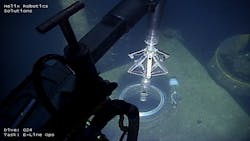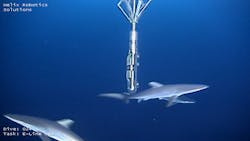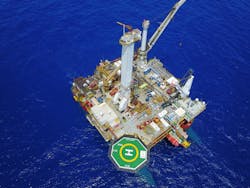Rigless approach improves efficiency for P&A project in deepwater Gulf of Mexico
Editor's note: This story first appeared in the September-October 2022 issue of Offshore magazine. Click here to view the full issue.
By Marcio de Araujo, Schlumberger, and Dhananjay Dhorje, Helix Energy Solutions Group, Inc.
Plugging and abandoning a well can be a complex and time-consuming operation—and over the past several decades, few advancements have occurred in the space to change this.
For offshore operators, it’s often not a question of when P&A work needs to be done, but can it be done more efficiently to save time and money while still achieving the high safety standards required to plug and abandon a well?
This is a question an independent operator in the Gulf of Mexico (GoM) had top of mind on a recent deepwater P&A project that they collaborated on with the Subsea Services Alliance—a partnership between Schlumberger and Helix.
Through the Subsea Services Alliance, the operator was able to efficiently perform a job using a rigless P&A approach and the latest P&A technologies available that helped shave days off the project from what would’ve been achieved using conventional technology.
Challenging deepwater well
One of the complications many operators can encounter during a P&A operation is not knowing the status of the cement behind the casing, which may have changed throughout the life of the well. The annular condition changes over the life of the well due to several factors, such as barite sag, the casing subjected to production or injection cycles, crossflow due to differential depletion, and formation squeeze from shales or salts. This complexity of annular composition and cement placement is somewhat easily resolved when the completion is a single cemented casing string using widely deployed ultrasonic and basic sonic measurements. However, barrier evaluation through tubing or multiple casings—as was the case for the GoM operator’s well—has long been an industry challenge.
To evaluate the C-annulus (behind 13 3/8-in. pipe) for well integrity through multiple casings using a traditional approach, the operator would mobilize a rig to access and remediate the well. This typically involved various steps:
- Perforate through multiple strings of pipe at least 300 ft above the open shoe
- Attempt to establish injection, with a contingency plan if injection was unsuccessful - reperforate 500 ft above the previous perforations to circulate in 300 ft of cement and attempt to inject into both sets of perforations
- Set an inflatable cement retainer (ICR) 50 ft above the bottom perforations and attempt to inject and test the ICR from below
- Pump cement through the bottom perforations, if possible, and laying 300 ft of cement above the ICR (or 550 ft of cement above the ICR if there are two sets of perforations)
- Wait for the cement to cure
- Pressure test the cement plug.
This traditional approach to P&A may take several days per well depending on the operational complexity, increasing P&A time and costs, so the operator wanted a way to improve operational efficiency while minimizing risk and ensuring all P&A regulations were met. The operator and the alliance collaborated on an approach that would enable evaluating the C-annulus barrier without removing the inner 9 5/8-in. casing string to eliminate remediation in wells that do not warrant it due to sufficient barrier quality.
Efficiency gains
The technology offers an advanced and highly accurate method for imaging the annular profile of both the first and second annuli simultaneously. It uses a unique combination of wireline-conveyed, deep-array multimode sonic (0.5–20 kHz) and multimodality ultrasonic (100–500 kHz) measurements. Unlike conventional tools that offer only monopole sonic measurement, multimodality ultrasonic measurement provides crucial information such as pipe-to-pipe standoff and a full characterization of the first annulus. Not knowing this information may otherwise affect interpretation in the second annulus when evaluating well integrity through tubing or multiple casings. So, the combination of multimode sonic and multimodality ultrasonic measurements delivers a more reliable evaluation of the second annulus, which is environmentally corrected, with radial coverage and azimuthal mapping.
With the comprehensive data that the dual-string barrier evaluation technology provides, operators are able to select evaluation output levels that best suit their well objectives and operational requirements. The operator used the technology’s axial and segmented bond log, derived independently from the dipole and eight azimuthal receivers and monopole transmitter, to accurately evaluate the bond quality behind the 13 3/8-in. casing.
By deploying the dual-string barrier evaluation technology, the operator eliminated removal of the inner 9 5/8-in. casing to accurately evaluate barrier integrity behind the 13 3/8-in. casing and assess whether remediation was necessary as part of the abandonment requirements. Data from the service enabled the operator to gain approval from Burea of Safety and Environmental Enforcement (BSEE) to abandon the well without setting a cement plug to seal the 13 3/8-in. × 16-in. casing annulus, saving two perforating runs, a cement retainer run, and a cement job to drastically reduce operational time and cost. The operator was also able to skip waiting on cement (WOC) for the plug, saving 19 hours. In addition, evaluating through multiple casings eliminated the HSE risks on naturally occurring radioactive material (NORM)-contaminated pipes, the cost of surface pipe handing, and transportation for disposal.
Project results
The rigless P&A approach using the Q4000 and dual-string barrier evaluation technology enabled the operator to use the high-quality evaluation results to streamline the P&A process and identify the course of action early, a more proactive approach than the traditional method. This avoided performing unnecessary remediation, saving days of operational time.
The operator also was able to reduce opex while improving service quality and reliability. The dual-string P&A barrier evaluation technology saved both operational time and cost of required services to squeeze a potentially opened casing shoe. Comparing the cost of services with the potential savings, the operator proceeded with using the dual-string P&A barrier evaluation technology for more informed barrier evalation, eliminating an unnecessary tubing removal or unneeded barrier remediation. This enabled the operator to perform cement squeeze on only well sections that demonstrated an insufficient barrier in the C-annulus. The sections where the evaluation showed a competent barrier in the C-annulus were left as is, saving substantial time in the operation.
The operator has four deepwater wells planned in 1Q 2023 and is considering deploying the dual-string P&A barrier evaluation technology in those wells to improve operations. The company also has several shallow-water wells to abandon on the shelf and is evaluating use of this technology to achieve efficiency gains.


